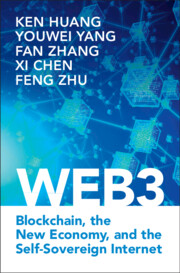Book contents
- Web3
- Reviews
- Web3
- Copyright page
- Contents
- About the Authors
- Foreword by Anthony Scaramucci
- Foreword by Yale Li
- Preface
- Acknowledgments
- Part I Foundations of Web3
- 1 Web3 Concepts and General Introduction
- 2 The First Principles of Web3
- Part II Technological Underpinnings of Web3
- Part III Applications and Use Cases of Web3
- Part IV Challenges and Future Horizons of Web3
- Index
- References
1 - Web3 Concepts and General Introduction
from Part I - Foundations of Web3
Published online by Cambridge University Press: 21 November 2024
- Web3
- Reviews
- Web3
- Copyright page
- Contents
- About the Authors
- Foreword by Anthony Scaramucci
- Foreword by Yale Li
- Preface
- Acknowledgments
- Part I Foundations of Web3
- 1 Web3 Concepts and General Introduction
- 2 The First Principles of Web3
- Part II Technological Underpinnings of Web3
- Part III Applications and Use Cases of Web3
- Part IV Challenges and Future Horizons of Web3
- Index
- References
Summary
Chapter 1 provides an overview of the concepts and definitions inherent to Web3. It presents a deep exploration into the phenomenon of "Convergence of Convergence," a term coined to denote the convergence of various dimensions within Web3, such as technology, data, user interactions, business models, identity, and organizational structures. The chapter also offers a comparative study of Web3 from different perspectives – tracing its evolution in the Internet era, analyzing its implications for user experience, evaluating its regulatory aspects, and understanding its scalability. Each of these aspects is explored in a detailed, standalone section, allowing readers to comprehend the multifaceted nature of Web3. The overarching aim of this chapter is to foster a comprehensive understanding of Web3, delineating its significance as a major shift in the Internet paradigm and its potential for creating more decentralized, user-empowered digital ecosystems.
Information
- Type
- Chapter
- Information
- Web3Blockchain, the New Economy, and the Self-Sovereign Internet, pp. 3 - 40Publisher: Cambridge University PressPrint publication year: 2024
